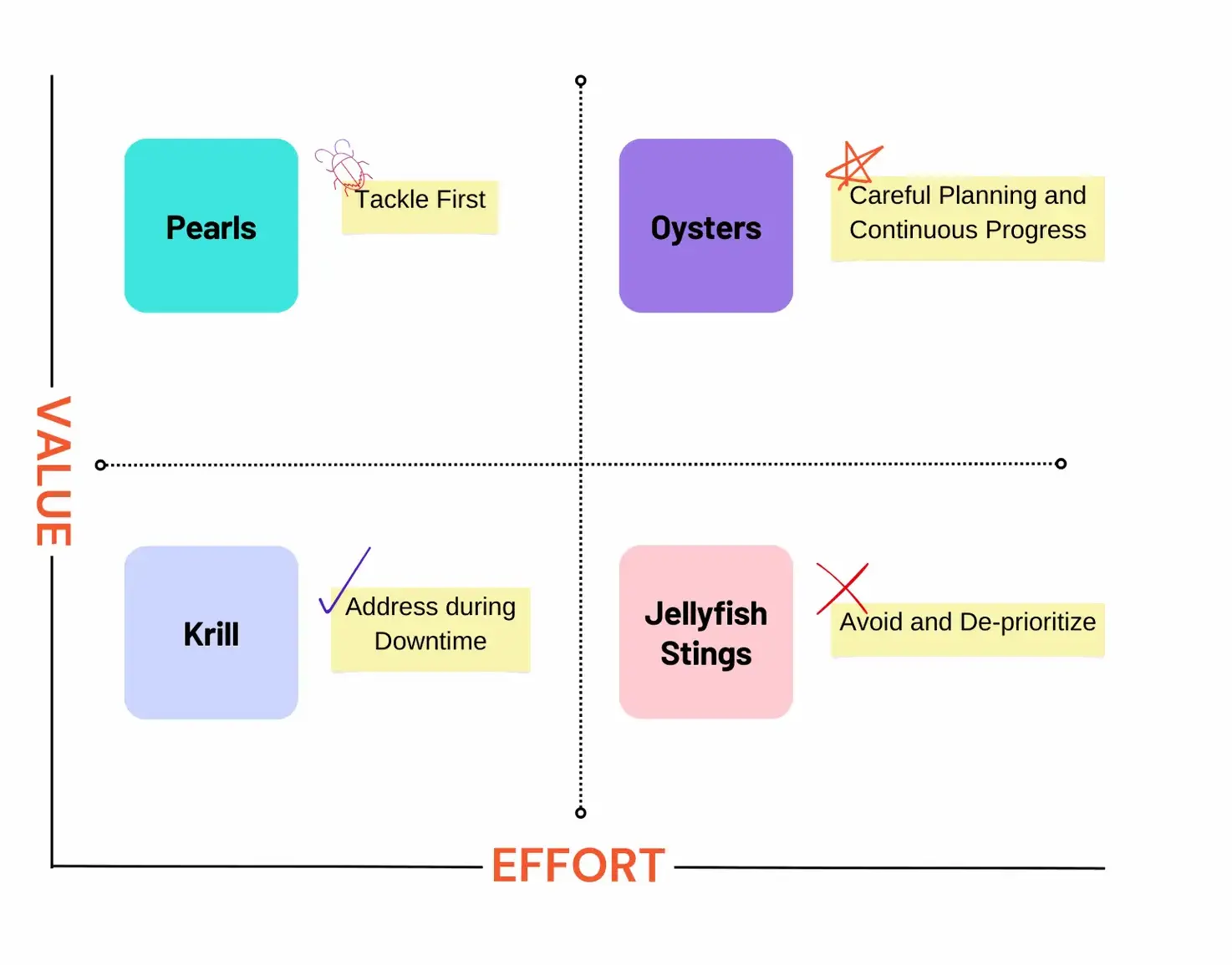When teaching the Value-Effort Matrix as a prioritization tool used to assess and rank tasks and initiatives, it’s useful to have memorable names for each of the quadrants.
The X-axis represents effort, which includes time, resources, or complexity required to complete a task.
The Y-axis represents value, which refers to the benefit or impact a task delivers.
The Four Quadrants
Quick Wins (High Value, Low Effort) aka Pearls
Tasks that provide significant benefits with minimal effort. These are high-priority items that should be tackled first for maximum return on investment.
Big Bets (High Value, High Effort) aka Oysters
Initiatives that are resource-intensive but have the potential for transformative results.
These require careful planning and alignment with strategic goals.
Fill-Ins (Low Value, Low Effort) aka Krill
Low-priority tasks that can be addressed during downtime but should not take precedence over more impactful work.
Money Pits (Low Value, High Effort) aka Jellyfish Stings
Tasks that consume significant resources while delivering little value.
These should generally be avoided or deprioritized.

How to Use the Value-Effort Matrix (Pearls, Oysters, Krill and Jellyfish Stings)
List Initiatives: Identify all tasks under consideration.
Plot Initiatives: Place each task in the appropriate quadrant based on its value and effort scores.
Prioritize:
Focus on Pearls (High Value, Low Effort) for immediate results.
Plan Oysters (High Value, High Effort) strategically, as they require significant resources but offer big rewards.
Address Krill (Low Value, Low Effort) as secondary priorities during downtime or when resources allow.
Avoid or eliminate Jellyfish Stings (Low Value, High Effort), as they consume resources without delivering meaningful value.
Benefits of the Matrix
- Simplifies Decision-Making: Provides a clear visual representation of priorities.
- Aligns Teams: Provides a common language for discussion and helps allocate resources effectively.
- Reduces Bias: Offers an objective framework for evaluating tasks and initiatives.
The example I often share when teaching this matrix is that of “The Cockroach Catcher”. When faced with creepy crawlies, especially cockroaches, my girls (and I) look to George to handle it. Since our family supports a compassionate approach, the only acceptable way is to trap it in a plastic container and with a piece of paper board, lifted up and brought out farther into the garden and released. That speaks of a lot of time spent in close proximity with any disagreeable creature, and that is provided you can catch it to start!
So for us girls, catching a cockroach is an Oyster (really, an impossible effort, high value) activity but for George, it’s a Pearl (low effort, high resultant value) activity since he will never hear the end of it if the cockroach escapes.
Therefore, the term “Cockroach” project has been coined as tasks that are easy for you to do, yet seen as really high value to others.
A group of my clients started using this internal speak as they work through their annual plans. They ask one another to identify “cockroach projects” for the year. Besides the giggle, these projects end up really memorable and achievable, much to their delight!
Case in point, yesterday night, George had to catch a giant cockroach in our home. Unlike the Singapore cockroaches, the ones here in South Africa cannot fly. He moved that one into our garden while our girls and I were so starry-eyed and impressed. George our Hero!
Serendipitously, another client of mine shared how Singapore has deployed cyborg cockroaches to assist with search-and-rescue efforts in Myanmar following a 7.7-magnitude earthquake. Developed by the Home Team Science and Technology Agency (HTX) with Nanyang Technological University and Klass Engineering and Solutions, these insect-hybrid robots are equipped with infrared cameras and sensors to navigate tiny spaces under rubble. Although they haven't found any survivors yet, they are helping the Singapore Civil Defence Force's (SCDF) team cover ground in some of the worst-hit areas, marking the first time such cyborgs have been used in a humanitarian operation.
https://www.straitstimes.com/singapore/spores-cyborg-cockroaches-helping-with-search-and-rescue-efforts-in-myanmar-quake
Does the above make you like cockroaches more now?